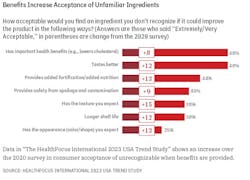Food technologies tend not to receive the same positive response from consumers and media as advances in areas such as medicine and information technology. Due to a confluence of factors – especially environmental and animal welfare concerns -- this may be changing, with dramatic developments in how we source and process foods … and consumers’ willingness to accept them.
One category, emerging protein sources for formulated foods, exemplifies many of these trends.
Two novel technologies being applied to protein production are cellular agriculture and biofermentation. In cellular agriculture, cells from living animals are collected and mechanical and enzymatic techniques produce muscle tissue for consumption. In fermentation, a process that does not involve animals, organic molecules are “biofabricated” from microorganisms.
The Good Food Institute further subdivides fermentation technologies. Biomass fermentation uses the high-protein content and rapid growth of microorganisms to efficiently make large amounts of protein-rich food. Quorn, based on filamentous fungi fermentation, is a well-established example. In contrast, precision fermentation uses genetically programmed microorganisms to convert nutrient material into ingredients such as protein.
These and other alternative protein products are finding their way into applications from center-of-plate entrees to soups, salads and appetizers. But before these products even test the consumer waters, they must first meet the scrutiny of R&D staffs.
Regardless of its source, “When choosing a new protein ingredient for use in a food or beverage application, many factors influence the decision,” says Cosmin Beliciu, project leader at National Food Lab (www.thenfl.com), a product development firm. Most ingredient criteria can be placed into three major groups:
- Fit with product concept and market position: Product developers need to establish if the ingredient has allergenicity issues, certifications such as “organic,” and if it will be accepted by consumers.
- Nutrition and regulatory considerations: An ingredient’s protein content and essential amino acid profile also need review, including total amino acid composition and limiting essential amino acids. If it is not a complete protein, establish if a complementary blend can be formulated to optimize the ingredient’s biological value (e.g., grains/nuts/seeds + legumes). “The availability of different purity grades (flour, concentrate or isolate) impacts the ingredient’s usage rate, especially if a claim is desired,” says Beliciu. The GRAS status must be confirmed, and whether anti-nutritional factors (compounds that lower the bioavailability of nutrients in foods) are present.
- Commercial (acquisition) considerations: The ingredient’s availability is also a factor. It is important to know whether the ingredient is a commodity or is in the proof of concept/R&D stage. The ideal ingredient should also have a reliable supply chain and a lower cost per unit.
“When selecting a new protein ingredient, these three criteria can be assessed as a paper exercise before even evaluating a sample,” says Beliciu. Other core criteria involve the ingredient’s performance and sensory characteristics like functionality, aroma, flavor, texture, mouthfeel and color. These will be impacted by the ingredient source and process history (extraction, purification, physical or chemical modification).
As food processors work to identify and evaluate ingredients for R&D tool chests, suppliers are developing functional proteins that will improve food production, reduce waste by valorizing ingredients, and/or are the products of new alternative technologies. Here are just a few examples.
From untapped sources
EverGrain’s (evergrainingredients.com) EverPro upcycled barley protein is an example of protein ingredients obtained from an underutilized raw material: spent grains from beer-making, in this case brewer AB InBev. The company reports it is a “first of its kind isolate” with high solubility, low viscosity and a mild taste.
EverPro is a key component in Osage Food Products’ (osagefood.com) SolvPro 008 and 009 systems, a line of optimized protein blends that combines the barley and pea protein isolates for a PDCAAS of 1.0., which delivers targeted functional properties in nutritional products.
An allergen statement “Contains Lupin” is advised as up to 20% of people with peanut allergies are also allergic to lupin. Lupins naturally sequester nitrogen into the soil, and studies have shown they reduce carbon emissions by up to 50% in a two-year lupin/wheat crop rotation.
Fermotein from the Protein Brewery (www.theproteinbrewery.nl/fermotein) is an alternative fermented, fungi-based, versatile whole food ingredient. Deb Anderson, director of new business development, describes the challenges of bringing such an ingredient to market: “It’s a new, unique and novel ingredient, which makes it exciting at the same time,” she adds. “Finding the right innovative product developer willing to bring the story to consumers is challenging since there is no data from which to draw.”
As with any new product, not knowing how consumers will accept it also is a challenge. However, “Most potential customers are excited to learn more and like the uniqueness of Fermotein with its lack of flavor, complete protein (PDCAAS = 1.0) and high dietary fiber content,” Anderson says. These properties are especially useful in the better-for-you, gluten-free bakery space. “Our ingredient allows the inclusion of protein and fiber into the delicate texture of bakery items without negatively affecting the texture due to its unique inertness.”
Krill Artic Foods’ (krillarcticfoods.com) founders first encountered krill for human consumption in Eastern Europe. Krill are small marine crustaceans found in all the world's oceans, similar to but much smaller than shrimp. With the stated mission “to provide high quality, sustainably sourced Antarctic krill meat,” the company started selling retail tins in the U.S. in early 2023 and intends to sell to food processors by the end of the year.
The ingredient is an excellent source of omegas 3, 6 and 9 and a “quality source of protein” at 15g protein per 105g serving. At less than 100ppm, it’s low in heavy metals since it's low on the food chain.
Sustainability is a key consideration. The company, authorized to fish in the Antarctic Ocean, follows guidelines established by the Commission for the Conservation of Antarctic Marine Living Resources (CCAMLR). Due to krill’s importance in the marine ecosystem, CCAMLR sets a “trigger” annual harvesting quota of 1% of the estimated 60 million tonnes (132 trillion lbs) of krill biomass in the southwest Atlantic.
Aker Biomarine (www.akerbiomarine.com) also is working within the guidelines of CCAMLR to supply krill protein. They launched Understory, a self-affirmed GRAS protein hydrolysate. Produced by a patented process, Understory is more than 90% protein and has a “complete, well-balanced amino-acid profile” in peptide form for easy digestion. Functional benefits include being clear in solution, 100% soluble, pH and heat stable, and low viscosity.
Trying to unseat soy
Despite all the current interest, emerging protein sources supply a small portion of the world’s “processed” ingredients. A “Global Protein Ingredients 2021-2026” report by Giract notes that in 2021, soy was the source of almost 60% of the global plant protein supply, followed by wheat (32%), pea (6%), potato (2%) and rice (1%).
A wealth of research into the properties, processing, applications and affordable price of soy aids its dominance. Soybeans also possess many other components of high value to the food industry, says Giract.
Although pea and rice protein ingredients are established, their use demonstrates an important trend in both traditional and emerging protein ingredients. Pea protein is high in lysine but low in the amino acids methionine and cysteine. Rice protein, meanwhile, is low in lysine and high in methionine and cysteine. So the two have become a popular pairing among product developers.
Other fruitful combinations include legumes (e.g., lentils, chickpeas, beans and peas) with grains and seeds (e.g., corn, wheat, barley, sesame and sunflower.) Grains are also helped with the addition of milk proteins.
While not all food marketers agree, a consensus among larger manufacturers and legal experts is that protein content claims outside the Nutrition Facts Label imply a “Good Source of Protein.” To make this claim, regulations require products to have at least 5g of quality protein per serving (i.e., 10% DV / Daily Value), stated David Plank, managing principal at WRSS Food & Nutrition Insights. The %DV depends on a protein’s PDCAAS value.
For a product’s true PDCAAS value, animal testing is required, which takes time, is expensive and many in the plant-based community oppose it. Increasingly ingredient suppliers are assisting the product development process by pre-blending protein sources to provide ingredients of known PDCAAS values, often guaranteeing a score of 1.0 for the ingredient.
Getting consumers, who are notoriously guarded about new food technologies in general, to accept emerging proteins presents a barrier. A barrier that may be lowering.
The “HealthFocus International 2023 USA Trend Study” asked, "How acceptable would you find an ingredient you don't recognize if it could improve the product in the following ways?" 48% of respondents said the ingredient was "extremely/very acceptable" if it had important health benefits or improved the product's taste. This was an 8 and 12 percentage point increase, respectively, compared to 2020 survey responses. For other benefits applicable to protein ingredients, see the chart “Benefits Increase Unfamiliar Ingredient Acceptance.”
The use of science and technology in the food industry is still a bit foreign to consumers. Still, they generally accept these new technologies if they result in better products that can be made without undesirable ingredients and/or possess holistic benefits, such as being more sustainable, ethical or supportive of food security, says Johnson.




